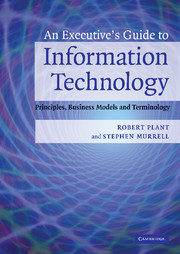Book contents
- Frontmatter
- Contents
- Introduction
- A ACM (Association for Computing Machinery) to Audio
- B Backup to Business process re-engineering
- C C, C++, C# to Cracking
- D Database to Dynamic web pages
- E e-Commerce/e-business to European Union Directive on Privacy and Electronic Commerce 2002
- F Fiber optics to Fuzzy logic
- G to H Global positioning system to Hypertext, HTML
- I ICANN (Internet Corporation for Assigned Names and Numbers) to ISP (Internet service provider)
- J to L Java to Logic programming
- M Machine learning to Multicast
- N Natural language processing (NLP) to Normalization
- O Object-oriented to Outsourcing
- P Packet switching and circuit switching to Public key-private key
- Q to R Quantum computing to RSS (Really simple syndication)
- S Sarbanes-Oxley Act of 2002 (SOX) to Structured design methodologies
- T to U T-Carrier to URL (Uniform resource locator)
- V Value added network (VAN) to Voice over IP (VoIP)
- W W3C (the World Wide Web Consortium) to WYSIWYG
- X to Z X.12 to Zip
- Index
- References
B - Backup to Business process re-engineering
Published online by Cambridge University Press: 17 May 2010
- Frontmatter
- Contents
- Introduction
- A ACM (Association for Computing Machinery) to Audio
- B Backup to Business process re-engineering
- C C, C++, C# to Cracking
- D Database to Dynamic web pages
- E e-Commerce/e-business to European Union Directive on Privacy and Electronic Commerce 2002
- F Fiber optics to Fuzzy logic
- G to H Global positioning system to Hypertext, HTML
- I ICANN (Internet Corporation for Assigned Names and Numbers) to ISP (Internet service provider)
- J to L Java to Logic programming
- M Machine learning to Multicast
- N Natural language processing (NLP) to Normalization
- O Object-oriented to Outsourcing
- P Packet switching and circuit switching to Public key-private key
- Q to R Quantum computing to RSS (Really simple syndication)
- S Sarbanes-Oxley Act of 2002 (SOX) to Structured design methodologies
- T to U T-Carrier to URL (Uniform resource locator)
- V Value added network (VAN) to Voice over IP (VoIP)
- W W3C (the World Wide Web Consortium) to WYSIWYG
- X to Z X.12 to Zip
- Index
- References
Summary
Foundation concepts: Storage, Information lifecycle management, Power protection.
Definition: Secondary copies of data and applications kept to guard against catastrophic loss in the event of a system failure.
Not to be confused with:BackUPS, the trade name of a variety of uninterruptible power supply.
Overview
Hardware failures do occur. They can be made less common by using only the most reliable hardware components, employing all available power protection technologies, and regularly monitoring system performance to catch problems before they occur, but nothing can prevent unexpected failure.
When a computer system suffers a hardware failure, it will sometimes leave data stored on disks undamaged, but some failures can destroy a disk drive, and some will result in damage to files: if an application is actively modifying a data file when the computer suddenly stops working, the file can be left in an intermediate state with just half of the change made (perhaps a balance transfer had credited one account but not yet debited the other), leaving the file's state invalid.
Sadly, amongst the most common forms of hardware failures are failures of the disk system itself. Damage may range anywhere from a slight degradation in performance to a complete loss of all data and the disk itself becoming unusable.
Additionally, software problems are very likely to cause loss of data. The presence of Bugs in applications is extremely wide-spread, and, if an application is “buggy,” it could do anything from occasionally failing to update files completely to accidentally deleting everything stored on the disk.
- Type
- Chapter
- Information
- An Executive's Guide to Information TechnologyPrinciples, Business Models, and Terminology, pp. 24 - 45Publisher: Cambridge University PressPrint publication year: 2007



